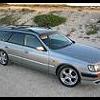Jun 2.7l Stroker Build Underway (hks T04z)
Announcements
-
Similar Content
-
Latest Posts
-
That's probably OK. That's a face to face compression joint between two surfaces with the clamping load provided by those bolts. So.... it's unlikely that the bolts will end up feeling that load in shear, unless the clamping surfaces are not large enough, bolts not got enough tension on them, etc etc to prevent the two faces from moving wrt each other. Which... I would hope the designers have considered, seeing as it's probably one of the most important things the upright has to do apart from resist collapsing in its own right. But yes, it would definitely be worth asking them what their safety factor on that part of the design was. I tend to think that the casting, being a casting, is not necessarily the strongest bit of material in the world. It's about an inch square, and when you think about the loads that are being put into it, you have to wonder what safety factor the Nissan boys (and every other OEM engineer who has designed all the millions of other uprights that look essentially the same) used to account for defective casting, aging, severe impacts on the wheel, etc etc.
-
Those bolts would be orders of magnitude stronger that cast aluminium though. And its mainly clamping force, not shear they are dealing with?
-
Except all that twisting force that is breaking a cast piece, appears to be going through 4 bolts in the picture Johnny posted of the BryPar one...
-
The smart approach is to use the gearbox loom from the manual car. Makes it a lot easier - just plugs into the switches on the box and plugs into the main loom up near the fusebox. Then you only need to deal with bypassing the inhibit switch. The other approach requires you to use the wiring diagram to identify those wires by colour and location, perhaps even indulging in a little multimeter action to trace them end to end to make sure, and then.... you will have the answers you need. The R34 wiring diagram is available on-line (no, I do not have a link to it myself - I would have to do a search if I wasn't able to go to the copy I have at home).
-
Hi, i’m converted my r34 4dr auto to manual but need help with gearbox wiring. There are bunch of wires no idea which one for speedo drive, neutral, reverse can anyone help me. IMG_6860.mov
-







Recommended Posts